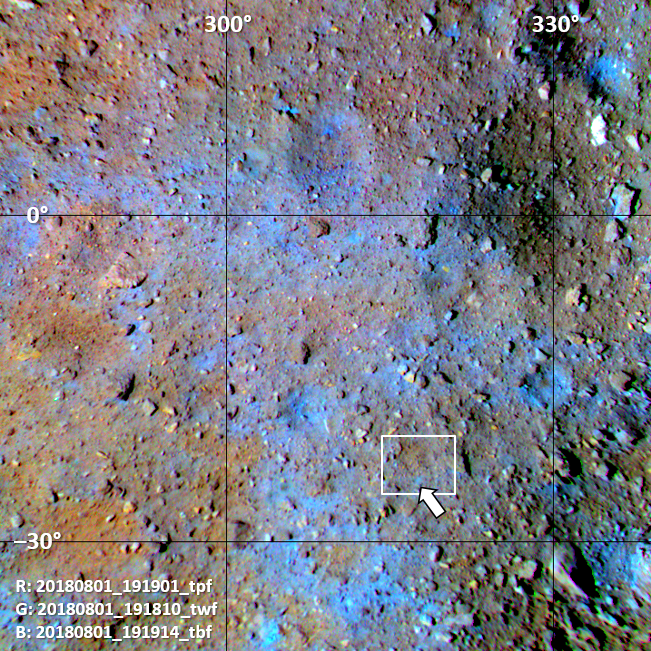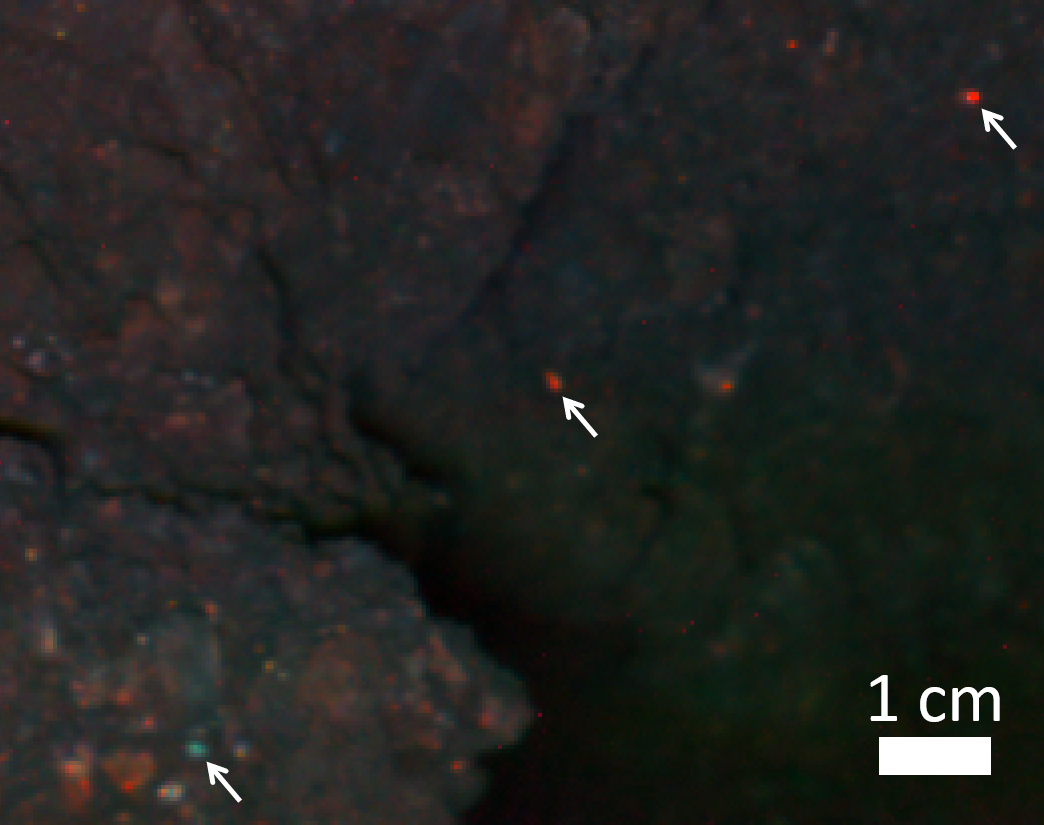Characterizing the MASCOT landing area with Hayabusa2: Linking the MASCOT rock to the Ryugu samples
- 1Luleå University of Technology, Sweden (stefanus.schroder@ltu.se)
- 2ISAS, Japan Aerospace Exploration Agency, Sagamihara, Japan
- 3Kochi University, Kochi, Japan
- 4IAC, University of La Laguna, Tenerife, Spain
- 5Planetary Science Institute, Tucson AZ, USA
- *A full list of authors appears at the end of the abstract
Background
After landing on Ryugu, The Mobile Asteroid surface SCOuT (MASCOT) settled in front of a rock that was a bit larger than itself. Multispectral imaging of the rock revealed a dark matrix with numerous small, bright, multi-colored inclusions (Jaumann et al. 2019; Schröder et al. 2021). While these inclusions appear similar to those in carbonaceous chondrite (CC) meteorites, the rock is not easily associated with any particular CC group (Schröder et al. 2021; Otto et al. 2021). Now we can directly compare the MASCOT observations with particles from Ryugu. The samples are considered representative for the asteroid surface (Tachibana et al. 2022), but the particles harbor no chondrules and Ca-Al-rich inclusions larger than a millimeter (Yada et al. 2021). Is the MASCOT rock perhaps unusual for Ryugu? We put the in-situ MASCOT observations in the context of remote observations of the landing site by the Hayabusa2 instruments. The optical navigation camera (ONC), near-infrared spectrometer (NIRS3), and thermal infrared imager (TIR) mapped virtually the entire surface multiple times over the course of the mission (Sugita et al. 2019; Kitazato et al. 2019; Okada et al. 2020).
Hayabusa2 observations of the landing area
MASCOT was aimed to land in an area just south of the equator that was chosen for its high potential for spectroscopic diversity (Lorda et al. 2020). Of particular interest is "blue" terrain, which features a neutral to negative spectral slope and is thought to expose fresh material (Sugita et al. 2019; Morota et al. 2020). The lander came to rest in the area indicated by the white rectangle in Fig. 1, which appears almost devoid of blue terrain. Figure 2 zooms in on the landing area, showing color composites of three separate ONC image sets. Composite (a) is made from images acquired two months before the release of MASCOT and shows the landing site at relatively low resolution. Composite (b) is made from images acquired just after landing and has a bright spot at the landing site that corresponds to the lander's highly reflective, white top side. The lander has the size of a single pixel in the original, unprojected images, so neither its shape nor orientation can be distinguished. Composite (c) is made from images acquired half a year after landing, and shows the lander on its side (Scholten et al. 2019). The inset in Fig. 2c shows MASCOT in close-up. The lander appears no longer white but has assumed an orange color, which derives from the foil that covered its sides. In addition to the ONC data, we analyzed two NIRS3 spectral data sets and six TIR data sets, as our presentation will show in detail.

Figure 1. Composite of projected ONC images acquired prior to the MASCOT landing, with colors saturated. The white rectangle is the area detailed in Fig. 2. The arrow points at a small, distinctly blue feature that we identified as an impact crater.

Figure 2. Color composites of identically projected ONC images of the MASCOT landing area. The arrows point at the landing site. (a) Before landing. (b) Right after landing, with MASCOT in the nominal orientation. (c) Half a year after landing, with MASCOT in the final orientation. The brightness in each composite is scaled from zero to the maximum reflectance over all color channels. The insets show close-ups of MASCOT.
Implications
Our analysis of data from Hayabusa2 instruments reveals that the MASCOT landing site has spectral and thermophysical properties very close to those of average Ryugu. While the Ryugu particles lack inclusions, the MASCOT rock features bright and strongly colored spots (Fig. 3). The apparent discrepancy between the rock and the Ryugu samples may simply illustrate the diversity of rocks present on the surface (Tatsumi et al. 2020; Sakatani et al. 2021). Alternatively, it may derive from the sampling method, which involved shooting a pellet into the surface (Morota et al. 2020). The samples display compositional heterogeneities at sub-mm scale. Among the bulk of dark particles, there are several bright particles of about 0.5 mm size that harbor carbonates or NH-rich compounds (Pilorget et al. 2021). Some carbonate-rich grains feature a steep red slope at wavelengths <1.6 µm. These characteristics well match those of the inclusions in the rock (Fig. 3). Such bright particles may be embedded in rocks on Ryugu, ending up as individual particles in the samples after being dislodged upon pellet impact or during atmospheric entry. Some rocks on the surface of Ryugu are thought to be breccias (Sugita et al. 2019), and the MASCOT rock may be one of them.

Figure 3. Inclusions in a rock on Ryugu as seen in a MASCOT color composite. The arrows point at a few brightly colored examples. Colors are saturated (Schröder et al. 2021).
References
Jaumann, R. et al. 2019, Science, 365, 817
Kitazato, K. et al. 2019, Science, 364, 272
Lorda, L. et al. 2020, Planet. Space Sci., 194, 105086
Morota, T. et al. 2020, Science, 368, 654
Okada, T. et al. 2020, Nature, 579, 518
Otto, K. A. et al. 2021, Planetary Science Journal, 2, 188
Pilorget, C. et al. 2021, Nature Astronomy, 6, 221
Sakatani, N. et al. 2021, Nature Astronomy, 5, 766
Scholten, F. et al. 2019, A&A, 632, L5
Schröder, S. et al. 2021, Planetary Science Journal, 2, 58
Sugita, S. et al. 2019, Science, 364, 252
Tachibana, S. et al. 2022, Science, 375, 1011
Tatsumi, E. et al. 2020, Nature Astronomy
Yada, T. et al. 2021, Nature Astronomy, 6, 214
Yuichiro Cho, Shingo Kameda, Kohei Kitazato, Toru Kouyama, Moe Matsuoka, Akira Miura, Tomokatsu Morota, Tatsuaki Okada, Hirotaka Sawada, Hiroki Senshu, Yuri Shimaki, Seiji Sugita, Satoshi Tanaka, Hikaru Yabuta, Manabu Yamada, Matthias Grott, Maximilian Hamm, Tra-Mi Ho, Ralf Jaumann, Stefano Mottola, Katharina Otto, Nicole Schmitz, Frank Scholten
How to cite: Schröder, S., Sakatani, N., Honda, R., Tatsumi, E., Yokota, Y., and Domingue, D. and the Hayabusa2 and MASCOT teams: Characterizing the MASCOT landing area with Hayabusa2: Linking the MASCOT rock to the Ryugu samples, Europlanet Science Congress 2022, Granada, Spain, 18–23 Sep 2022, EPSC2022-204, https://doi.org/10.5194/epsc2022-204, 2022.

